Media | Articles
8 lost classics of the ’80s, all under $18,000
The 1980s was an odd time in the automotive world: It was a chance-taking era, with multiple entries that really made no sense then, perhaps even less sense now. Automakers and importers tried some things that simply didn’t work, and the failure wasn’t always the car’s fault. Here we present eight cars from the ’80s that could have made a major impact but, for one reason or another, did not.
All the cars are priced at under $18,000, and some quite a bit under that figure. All prices are based on Hagerty’s valuation of a #3, “Good” condition car—better than the average driver, but not a show winner. In other words, nicer-than-normal cars that could make for some interesting transportation.
The model year given is the first year the car was imported to the U.S., but not necessarily the first year it was made. Regardless, our value represents the entire model run of the car, even those that lasted into the 1990s. Here goes . . .
1983 TVR Tasmin 280i — $9100

British car builder TVR has long built some interesting, fun, and usually odd-looking sports cars such as the ovoid TVR Vixen 2500, but the cars got little traction in the U.S. That was supposed to change with the TVR Tasmin 280i convertible, a wedge-shaped, hand-built two-seater designed along the lines of the Triumph TR7 and Subaru XT that was first imported in 1983.
Running gear was a hodgepodge of bits and pieces from an astounding number of other cars—reportedly the ashtray in some later models actually came from the DeLorean DMC-12. The engine was the 2.8-liter Ford Cologne V-6; it was not a selling point to tell buyers the sports car’s engine was fresh from the early Ford Ranger and Bronco II. Transmission was a four-speed manual. Still, the 280i was fun to drive and undeniably distinctive, and many parts are still available—except, perhaps, for the ashtray.
1985 Bitter SC — $15,900
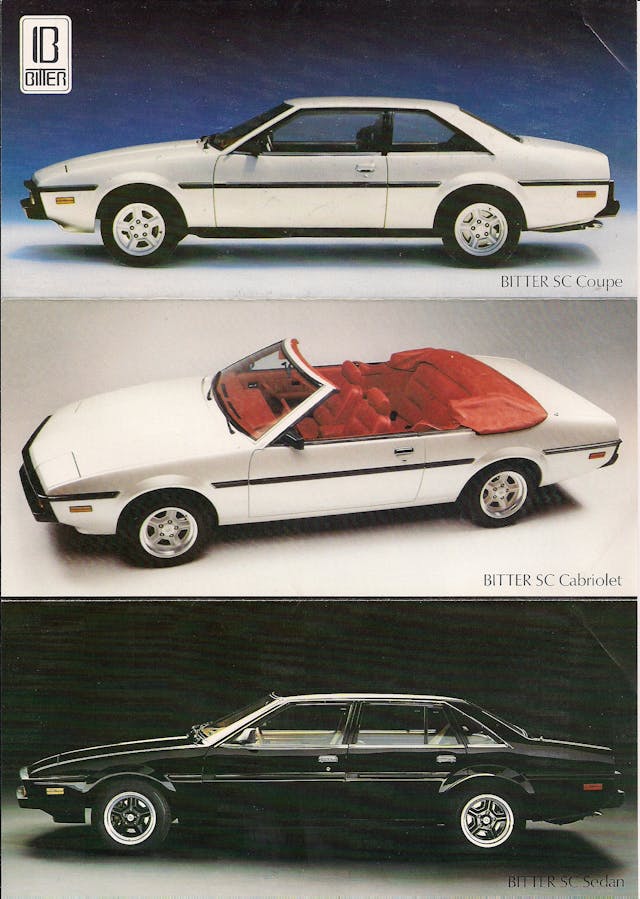
Erich Bitter, who died in July at age 89, was a professional race car driver turned car executive. He pieced together new models largely out of existing models, and his big push came in the 1980s with the Opel Senator–based Bitter SC. The car actually made it to America after the existing coupe was introduced at the 1984 New York auto show.
The Italian body of the SC looked a bit like a period Jaguar XJ-S and Ferrari 400i and was aimed at the Jaguar and comparable Mercedes-Benz and BMW models. Power was from an inline, fuel-injected Opel six-cylinder with either 177 or 207 horsepower, with a manual or automatic gearbox. General Motors tried to place the Bitter in Buick dealerships, but Buick salespeople had no idea what to do with the car. Sales were miserable. Regardless, the Bitter, when new, had an undeniably European luxury-car feel that made for a very pleasant tourer. No reason it still wouldn’t.
1989 Laforza — $9500
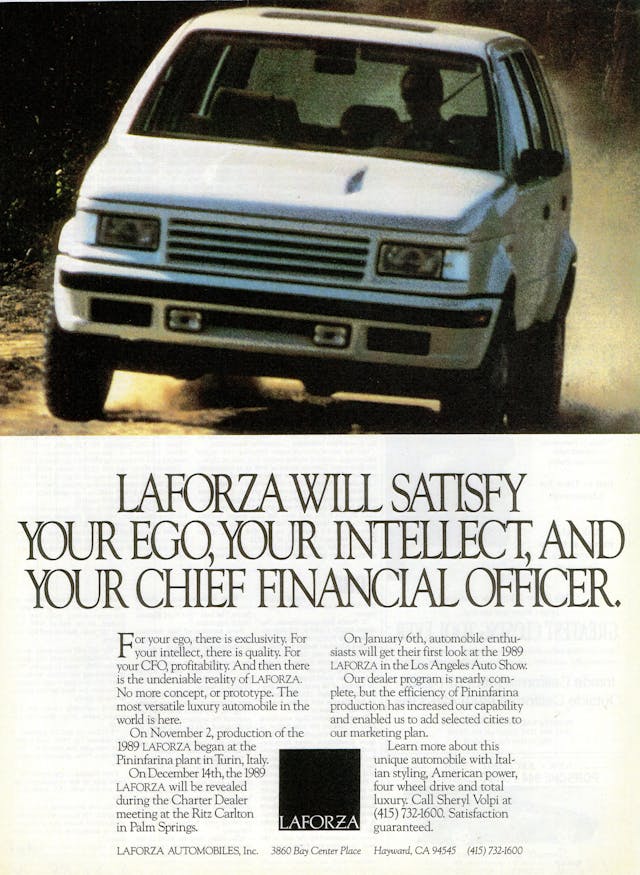
The Laforza was a big, heavy four-wheel-drive SUV that was supposed to take on Range Rover, but it lacked the moxie. It was powered by a fuel-injected 5.0-liter V-8 from Ford with an automatic transmission and a Chrysler transfer case. My overriding recollection of my Laforza drive was some of the worst brakes I’ve experienced in any vehicle, but it could have just been my tester (though it had rear drum brakes and no ABS).
The car began life in Italy as the Rayton-Fissore Magnum, first shown in 1984. The Laforza was built in Italy, with some U.S.-specific parts added by an aftermarket company in Michigan. Rather ungainly-looking outside, the interior was quite nice and had premium appointments. As with so many foreign startups, distribution was a fatal issue for the pricey Laforza. Only 1200 came to the U.S., so they are rare, but one shows up periodically online.
1989 Chrysler Maserati TC — $8500
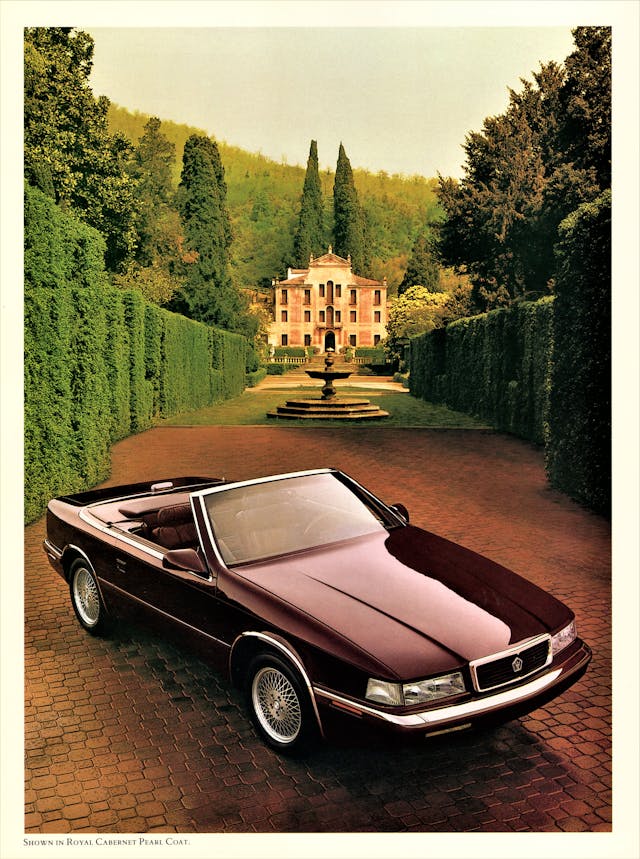
Former Ford executive Lee Iacocca was nothing if not ambitious by the time he took over Chrysler, and one of the things he coveted was a luxury gentlemen’s sports car. And he wanted it fast. The reason the car looks so much like a shortened Chrysler LeBaron coupe is that Iacocca loved the LeBaron; harried designers took the path of least resistance and basically copied the LeBaron, down to some parts and pieces. At least, that’s the story I was told then by a Chrysler executive.
Finally introduced at the 1986 Los Angeles auto show, the Chrysler Maserati TC didn’t show up until late 1988 as an uneasy collaboration between Chrysler and Maserati. The production delays were a standing joke among automotive journalists of the day. The powertrain was a turbocharged 2.2-liter four-cylinder, eventually replaced by a Mitsubishi 3.0-liter V-6. About 500 were made with a manual transmission and a 16-valve Cosworth/Maserati head: These are rare but a lot of fun to drive. Even today, the TC is not an unattractive car, and could be a nice oddball for Sunday drives.
1987 Cadillac Allanté — $8186

Undoubtedly the most outrageous grandstand play of the 1980s was the Cadillac Allanté. No expense was spared, especially with the bodies, which were made by Pininfarina in Italy and flown to Michigan 56 units at a time on specially equipped Boeing 747s. The car was remarkably expensive at about $57,000, or $150,000 in today’s money, though it is now the cheapest car in this list. The only option was a console-mounted cellular telephone.
The Allanté was exclusive, but not necessarily by GM’s choice, with only about 21,500 produced in seven model years. The two-seater shared some parts and a basic platform with the Cadillac Eldorado, and the powertrain was a slightly modified 4.1-liter Cadillac V-8 with an automatic transmission. In 1993, the Allanté got the more powerful 4.6-liter Northstar V-8 (below), but by then, its fate was sealed.
The Allanté was not really a failure: It drove, then and now, like the elegant roadster it was designed to be. But the massive depreciation tells the story—it was too expensive, too complex, too ambitious.
1989 Lotus Elan M100 — $13,100
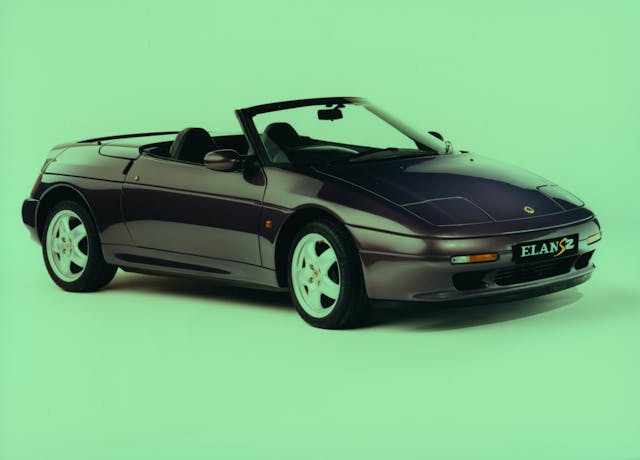
There was an interesting partnership between Isuzu and Lotus in the 1980s: Lotus engineered the suspension, quite effectively, for the little Isuzu I-Mark and the sporty two-door Impulse. Isuzu customers were impressed by Lotus, but Lotus customers not as much by Isuzu. Nearly 15 years after the last Elan—some would say the last real Elan—was sold, this Elan was front-wheel-drive and powered by a turbocharged 1.6-liter four-cylinder built by Isuzu but lightly modified by Lotus. The manual transmission was also by Isuzu.
Not surprisingly, Lotus loyalists were not amused, though the engine and transmission worked well. Many reacted as if International Harvester built the powertrain. The Elan’s styling wasn’t bad, but it arguably looked too much like the unloved Mercury Capri. To make matters worse, the Elan was introduced at about the same time as the Mazda Miata, and the market could absorb just so many small sports cars. This Elan had a lot going for it, but only 560 made it to the U.S.
1985 Merkur XR4ti — $9400

Ford had a roster of semi-sporty cars in Europe, and executives saw no reason why they wouldn’t work here. So they sent over the Merkur XR4ti which was supposed to take on the BMW 3 Series, and the Scorpio, targeted at the 5 Series. Both missed the target.
Ford’s Bob Lutz, fresh from a stint in Europe, was a fan of the European Ford Sierra, and reasoned that a version would do well in the U.S. It had a turbocharged, injected (hence the “ti”) 2.3-liter four-cylinder, essentially the same engine used in the Ford Mustang Turbo GT and Thunderbird Turbo Coupe. The hot ticket with the XR4ti was the five-speed manual-transmission cars because they had 175 horsepower, compared to a soggy 145 for automatics. Some of those three-speed automatics actually ended up in rental fleets.
The cars were continually upgraded but by 1989, Lutz’s European experiment was over, one reason being that few buyers looked to Mercury dealers for a BMW alternative. (The larger, four-door Scorpio lasted only two model years, 1988–89.) The XR4ti was a fun car while it lasted.
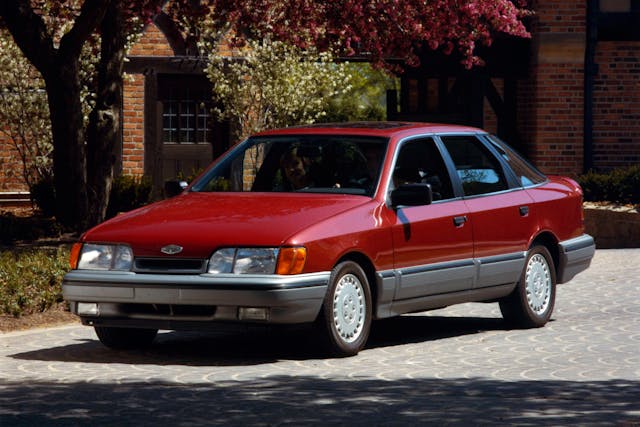
1983 Bertone X1/9 — $17,900
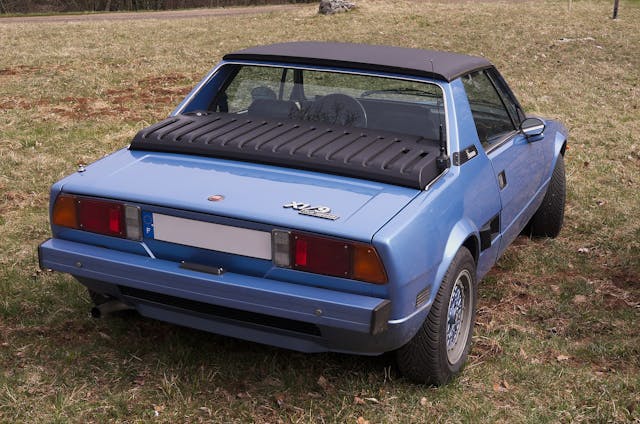
Malcolm Bricklin, the Orlando hardware store chain owner, wanted to be an automotive magnate, and he started by engineering the first importation of Subaru. From then he went on to build his own sports car, the interesting Bricklin SV-1, and to import the Yugo, a small car from Yugoslavia. It cost $3995 and was not quite worth the money. Then he set his sights on the Fiat X1/9, a midengined sports car that was a modest success in the states until Fiat quit importing it in 1982.
Bricklin arranged for the car to continue sales in the U.S. under the aegis of International Automobile Importers, dropping the name Fiat and calling it a Bertone; after all, Bertone now built it. IAI imported the X1/9 until 1987, and then for two more years, an X1/9 dealer in California imported some himself. The mid-engine sports car was arguably ahead of its time, and its long 15-year history in the U.S. meant aftermarket parts were available. The 1983 model had a 1.5-liter, fuel-injected four-cylinder and a five-speed transmission; it wasn’t fast, but handling was so good you’d think otherwise. More than 100,000 were imported to the U.S., but the little car is all but forgotten today.
***
Marketplace
Buy and sell classics with confidence
Check out the Hagerty Media homepage so you don’t miss a single story, or better yet, bookmark it. To get our best stories delivered right to your inbox, subscribe to our newsletters.


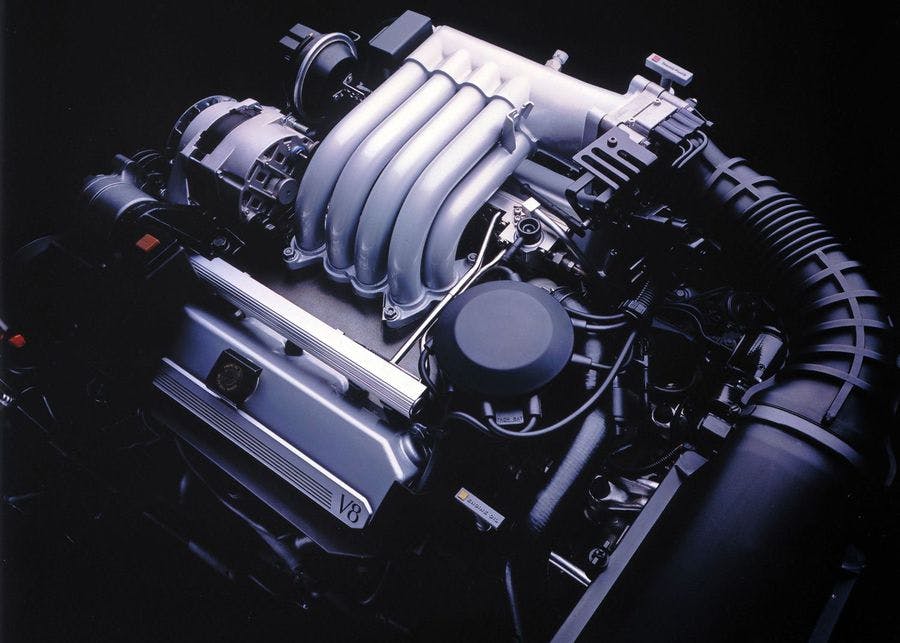


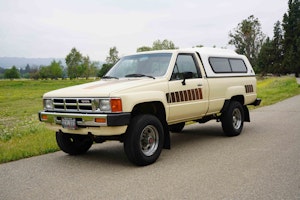

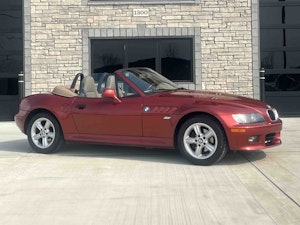
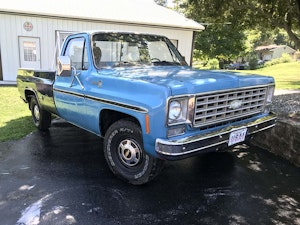









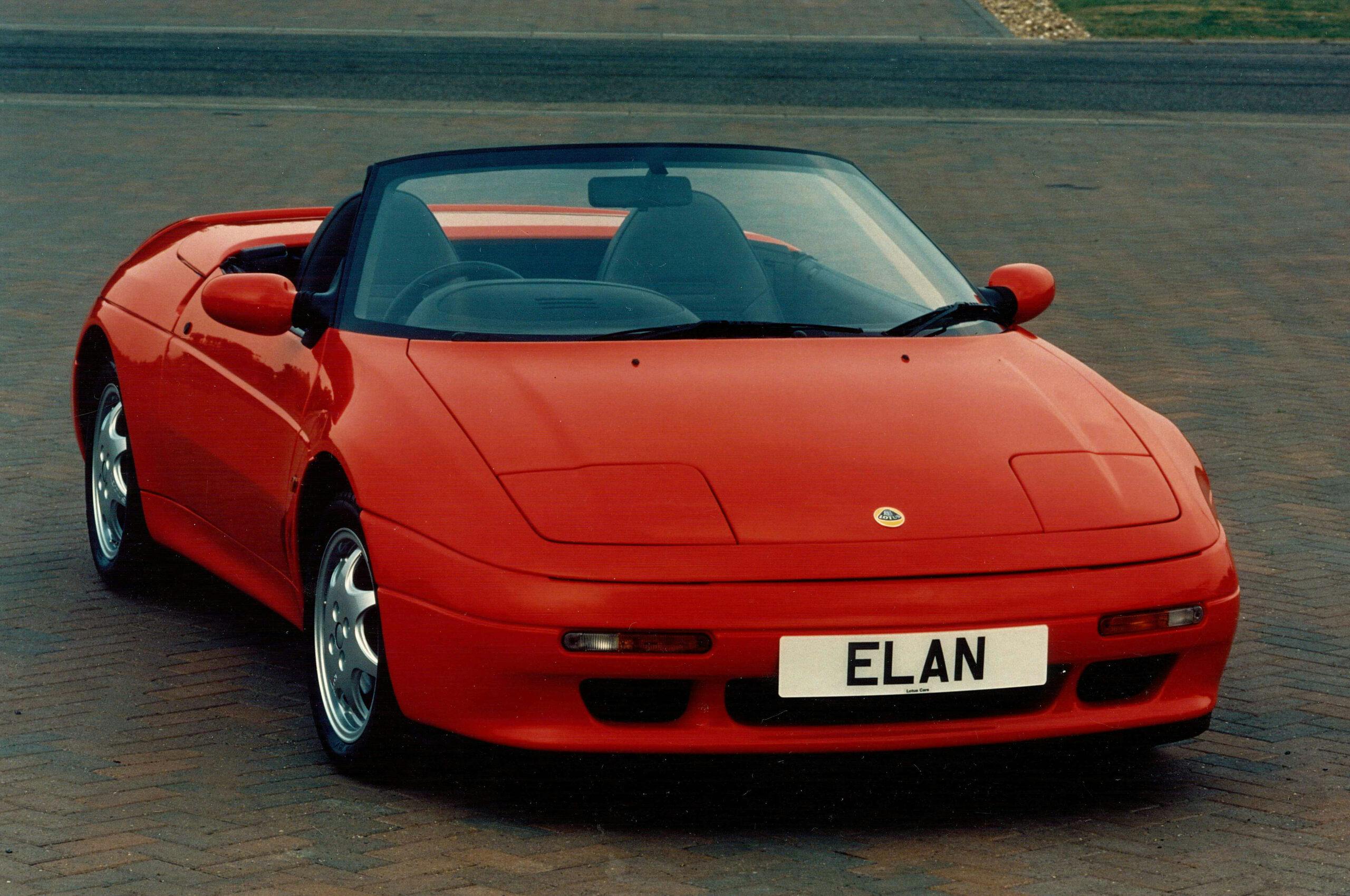
Let’s see. To park any of these in my garage I would have to put the 83 short bed stepside c10 and the 47 International hot rod outside. So none.
I bought a 1982 X1/9 fresh from the dealer when Fiat was exiting USA market and offering $2000 rebates, which you just didn’t find offered at the time. The first time I took it for emissions testing, it failed. The dealer had advanced the timing on this fuel injected 1.5, making it much sportier. Dialed timing back and it passed emissions but was noticeably slower. Handles like a go cart. Draws a ton of attention when I take it out. I’ve owned a lot of 2 seat sports cars, and the X1/9 is still one of my my favorites.
I loved them but could not afford one as a 1976 HS grad. This was a time when fuel was expensive, American cars were 1960’s technology with a bunch of cheaply engineered add-ons that robbed them of any fun factor. They were heavy with rail road bumpers and plastic everywhere.
These cars attempted to bring back some performance and road handling. BTW, my 1969 Cougar and 1972 Barracuda were great on straights, but basically and stylish Falcons or Dusters on curvy roads.
Their point was weight ratio and handling, like the older Mini Coopers or Elans. They sort of made the way for MR2s and Fieros as affordable mid-engine pocket rockets. There low price points both new and used meant they were purchased by young drivers who drove the heck out of them, parked them outside and often wrecked them. Hence another reason for their rarity.
I don’t want a car to just sit and look at, or to cruise to a coffee parking lot for bragging rights. I want one to drive. I was also a fool for the 2000 Spyder. Step up from an MGB and with some Ferrari design elements included.
I also owned an X1/9, drove it for 2 years, and loved it. No real problems that I couldn’t fix. It wasn’t fast but could handle and the ride was fine. I see more of them coming up for sale and might be tempted. To each his own but the X1/9 is a sleeper.
How about another AMERICAN car? 1979 to 1985 GM Eldorado, Riviera, Toronado. Classic styling, FWD well engineered, relatively easy to obtain parts and repair. I have owned an ’85 Riviera since new, a very good car with no drivetrain issues for 90K miles and 38 years, other repairs normal. Styling still gets attention and you can drive it on a daily basis if you want to. A literally brand-new ’85 Riviera with 40 miles brought $40K in an auction, nice low-mileage examples bring in the $ teens to 20’sK
Had an 85 Riv for many years. The air suspension system was a never ending headache. Maybe you’ve had better luck.
The Chrysler/Maserati TC was designed in conjunction with the LeBaron and purposely looked similar as it was supposed to be a “halo car” and was also supposed to be released BEFORE the LeBaron (you nailed the production delays that prevented that). There are no exterior body parts that interchange and even the structure is different between the two cars. The windshield cowling was co-developed by Chrysler and Maserati, hence the windshield glass can interchange, although they *are* different (physical size, tinting, UV protection, markings).
NOPE. None of the above. Scrap metal.
Back a while ago, I owned 2 Merkur Scorpios – best seating platform I’ve ever sat in. Smooth, exhilarating performance. Massive space in the rear hatchback. Dealer support, sadly, minimal.
A very motley crew, if the pick of the litter is a Chrysler. Hang on to your Krugerrands.
My father retired in the mid 1980’s. My parents both grew up in the generation with the mindset that you had “arrived” if you drove an new Cadillac. They began with an ’82 Seville. Dad traded that in 1987 for a new Deville. He was always a very social guy and made friends everywhere he went. When he was purchasing the Deville, he had retired and had also got to know several of the “higher ups” at the Cadillac dealership. They offered him a part time gig delivering dealer trades. This was a great deal for him. Kept him busy, got to drive new Caddys all the time and gave Mom a break. In late ’87 or maybe ’88 they asked him to fly to Nashville and bring back a new red Allante. Mom didn’t want dad to go that far so he suggested to them I would do it. So, I was in my late 20’s at the time, single, sort of employed and had some extra time. I got to fly to Nashville and drive back this brand new bright red Allante. It was a beautiful car. Ran great and few others on the road. I got it back with no issues and dropped by a couple of my friends house when I got back to town to show it off before turning it in. I figured, what’s a few more miles gonna hurt? I was a “big shot” for a day. Great memory.
Parts for the X1/9 are readily available including a lot of performance items. There’s also plenty of expertise found at owners groups and forums on social media. Have fond memories of mine.
I test drove a Lotus.
I was in the market for a daily driver sports car. My wife had a Toyota wagon.
The Lotus was a nice enough car, I wanted one primarily because of the name and heritage.
But the price was something else.
My choices were:
Miata…..$20,000
300ZX….$30,000
Lotus……$40,000
I bought the Miata.
I took my ’69 Dodge 440 6-pk clone to a prestigious Dodge/Chrysler/Ram dealership here in Houston and they looked at me with a blank stare and showed me the easiest way to exit the ramp. If they can’t plug and play, they don’t want to play at all!
Hagerty had put together some dumb (being nice) lists lately. Maybe they need to re-hire the car people they used to have.
Don’t read it then.
Save for the X-1/9 the list is rather under whelming. Even then an X-1/9 at $17,000 is unjustifiable. An AMG CL55 is still the best price : performance not on the list as well as C3 Corvettes.
How bad was the Lotus Elan??? So bad that it was sold, design, tooling, and all to Kia… LOL. Yes, there was a Kia Elan.. built from 96 to 99 in South Korea. They produced 1000 of them. https://www.hotcars.com/kia-lotus-elan-korean-market/